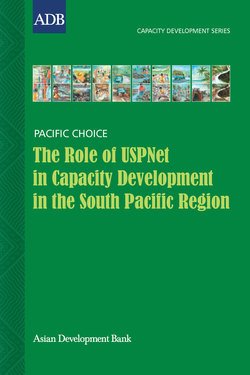Читать книгу The Role of USPNet in Capacity Development in the South Pacific Region - Ronald Duncan - Страница 7
На сайте Литреса книга снята с продажи.
INTRODUCTION
ОглавлениеThis case study tells the complex story of how a regional university has changed its delivery systems for teaching and learning to serve the growing needs for tertiary education of students living on thousands of small islands in the Pacific Ocean. It traces the history of the foundation of the University of the South Pacific (USP) by 12 island nations in 1968, and the development and use of its communications technology system called USPNet. It examines the role of the university as a regional capacity development institution for students, public and private institutions, and civil society by using satellite information technology to deliver first-class tertiary education.
USP is widely regarded as the best example of cooperation between the Pacific island countries.
USP is widely regarded as the best example of cooperation between the Pacific island countries. Indeed, some would say that it is the only successful example of such cooperation. Other attempts at regional cooperation, such as the formation of a regional airline, have failed—largely as the result of unwillingness to give up on the idea of national carriers or to cede sovereignty. Unwillingness to cede sovereignty by countries that have been independent for a relatively short period is perhaps understandable.
Developing a regional university to serve 12 tiny countries spread out over the vast Pacific Ocean was a monumental task. The fact that the University of the South Pacific has accomplished this feat and, moreover “manages to punch well above its weight in teaching and research”, in the words of its most recent vice-chancellor, is a testament to perseverance and to taking advantage of developments in the field of information and communications technology (ICT). At present, more than half of the university’s more than 20,000 students are distance students; that is, in the modern jargon, they are distance and flexible learning (DFL) students who learn with the assistance of modern telecommunications media—audio-conferencing, videoconferencing, and internet—as well as paper-based materials.
The case study describes how the university tapped into the initial stages of the development of satellite-based communication; how it has struggled to find the finance necessary to improve its crucial communications facility; how it has had to cope with the extremely high telecommunications charges and regulatory obstacles resulting from the monopolized telecommunications facilities in member countries; how it has contended with the enormous damage to infrastructure that can be inflicted by the physical environment; and how it has continually struggled to provide the most up-to-date multimedia learning to more than 10,000 DFL students studying in some of the most remote places in the world.
The communication difficulties facing the small communities in the small outlying islands and in remote areas of the main islands have long been a concern for Pacific peoples. The advent of global satellite coverage and the rapidly declining costs of computers and VSAT (very small aperture terminals) equipment, together with the availability of solar power, has opened up the possibility for people in remote communities to have immediate telecommunications contact with the rest of the world. This technology also opens up the opportunity for these communities to participate in the DFL offerings of USPNet. It is likely that the next big step for USPNet will be to develop its facilities to cater for this demand.
The case study suggests a number of strategic alternatives for further development of the university’s capacity in DFL, including bandwidth expansion to the 12 campuses and extension to the small rural communities where many students would prefer to undertake their studies. The challenge is to develop a strategic plan that will lead to the achievement of the University’s objective of making all its courses available by DFL by around 2010. But capacity development for the university is much more than full- or part-time tertiary training. There is a very important role for the university in delivering public education about important economic and social issues, such as health and disaster management, as well as playing a role in bringing together communities of experts to discuss common problems. USPNet can play a vital role in these kinds of activities.
